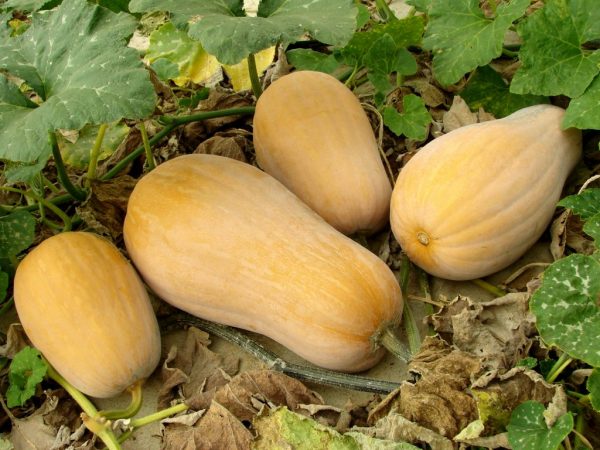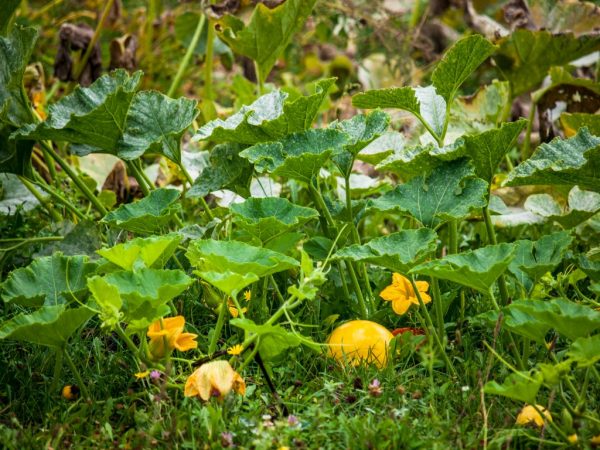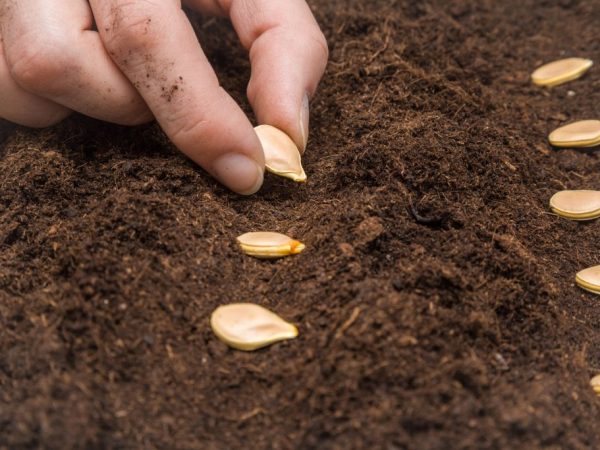Growing pumpkin Matilda
Matilda pumpkin is a hybrid brought to the local area from Holland. It was bred by breeders when crossed with other varieties of muscat species. After the culture entered the territory of Russia, it was entered into the State Register of the country with an indication of all the signs and characteristics.

Growing pumpkin Matilda
general characteristics
Pumpkin Matilda f1 is considered a dietary melon crop and has a high yield and unpretentiousness to the environment.
The culture is classified as a medium planting variety. The plant has a root system and a primordium, from which branches with a length of almost 5 m are woven. Later, yellow flowers appear on them.
After passing the selection, some inflorescences die and fall off, and the rest continue their formation and maturation. In mid to late September, it will be possible to harvest.
Sometimes pumpkins can be completely white. This manifests itself due to a lack of light.
The shape of the fruit can pleasantly surprise: there are both club-shaped and pear-shaped.
Due to the fact that the outer shell is highly durable, it retains its integrity during transportation.
When cooking, the pumpkin is easy to cut, it has a pleasant watermelon aroma, and the filling is quite dense with an average intensity of juice release. The rich orange pulp contains a lot of starch.
You may not find seeds in this vegetable. If you are lucky enough to find them, then they are located in the lower part of the fetus. If you grow the plant correctly, then as a result you can get up to 9 fruits weighing 2-3 kg each. The average germination time of a culture is 100 days.
Attention! At first, the pumpkin tastes unpleasant, but then the vegetable ripens at a positive temperature and is ready to eat. After harvesting the fruits, they can be stored for another 4 months without losing their taste and useful qualities.
Matilda seeds can be purchased at specialized stores. Price from 1900 to 2300 rubles for 500 pieces.
Dignity
- sufficient resistance to weather conditions and changing temperature conditions;
- harvesting takes place early in comparison with other fruit plants;
- the endurance of the hybrid to various diseases and harmful insects;
- rich harvest even in cloudy weather conditions;
- the seed box is small enough and therefore there will be few seeds in it;
- possesses good taste and pleasant aroma.
- can bring a good harvest even in summer, when the number of cloudy days will exceed clear ones.
According to the description, the only drawback of the Matilda pumpkin will be that its seeds will not be suitable for further reproduction and planting next year, since it is an F1 hybrid.
Yield

Top dressing will increase the productivity of plants
As mentioned earlier, Matilda pumpkin can have a good harvest.
To do this, during the planting season, it is necessary to carry out 2-3 dressings, which are based on mineral fertilizers, mullein and ash (after burning wood).
If the soil in a given area is not fertile enough, fertilizers can be applied 5 times.
Before the appearance of the first ovaries, the soil is fertilized with nitrogen impurities, and after the appearance of flowers - with phosphorus and potassium. But you should not be zealous with the addition of minerals, because an excessive amount of additives can negatively affect the growth of the crop, and all the nutrients are spent on the growth of greenery, not flowers and fruits.
The harvest is ready for harvest in mid-August. Gardeners determine the readiness for cutting the fruit by color. At the same time, the stalk begins to wilt and become harder, and the leaves slowly turn yellow and curl.
The crop is suitable for use for 4 months. During this period, pumpkin may even improve its flavor profile.
According to the description, up to 10 pumpkins weighing about 3 kg can be harvested from just one liana. But this volume can be increased by pinching.
Features of agricultural technology
With proper care and adherence to all growing rules, you can harvest a good crop weighing up to 25 kg from each bush. It is necessary to study the principles of agricultural technology.
- It is recommended to plant this variety in a lighted area with direct sunlight.
- As it overgrows and dries out, it is necessary to weed and fluff the ground, as well as water the beds and apply mineral fertilizers to them.
- In areas where climatic conditions do not allow growing a crop in soil, it is recommended to select it in greenhouses to comply with the required temperature regime.
The basis for growing must be prepared in the fall. To do this, first, they dig up the soil for better ingress of air and minerals, and then fertilize it. According to calculations, you need humus in a volume of 5-6 kg, together with superphosphate (50 g), to scatter over an area of 1 m2.
If the weather conditions do not allow the flowers to be pollinated naturally, they are processed by hand. It is also important not to use hybrid seeds for germination, because pumpkin F2 will not have the same properties as F1.
Seed preparation for planting and sowing
The pumpkin must be planted in a certain way. The seeds are sold in specialized stores, packed in bags of 500 pcs. They have already been processed in advance with special means, so gardeners do not need to prepare them before sowing. For their successful germination, the seeds are sown in shallow containers around the end of April and placed in a sunny place.

Seeds are sown in warm soil
The main criterion for planting seedlings in the ground is the warming up of the soil to a temperature of 15 °, as well as the period of its growth, which should be at least 4 weeks. In order to be calm in the event of the return of frost, the seedlings can be planted under the film.
Before sowing, the soil is well drained so that it picks up the required amount of oxygen. Most often, before planting, holes are made at a distance of 150 cm.
Matilda seeds are placed according to the scheme 180-210 cm by 100-180 cm.
1 hectare requires about 4 kg of seeds. If already germinated seedlings are used, then only 2 kg of seeds will be required. The average seed germination depth is 5-6 cm.
Care
After the planted seedlings, it will need to be watered abundantly so that the earth is well saturated. The next water supply will need to be performed only after 10 days, if there is no precipitation during this period.
This irrigation scheme stimulates the development and strengthening of the root system. In the future, it is recommended to water the beds once a week.
On average, 6 liters of water is used per 1 m² for the period that takes the growth and development of the plant until the first ovaries appear. After that, the volume of liquid will need to be increased to 10 liters so that the fruits are filled with nutrients and are juicy.It is also recommended to water the crop every 4 days to prevent it from withering.
The watering technique consists in accurately supplying water directly to the root of the plant so that drops do not fall on the leaves and flowers. In this case, the aqueous substrate must be warm. This should be especially taken into account during the period of maturation and growth of the fetus.
Also, in order to save liquid, you can make small ditches around each plant and fill them with water. This will reduce the volume of water and increase the access of the entire root system to moisture.
For better ripening, it is necessary to periodically feed the plant. But do not forget that the amount of fertilizer should not be in excess, otherwise the inflorescences simply will not have time to set and bloom. For feeding, you can use potassium salt, ammonium nitrate and superphosphate, then the crop yield will increase several times.
Harvesting
Ripe Matilda pumpkins are harvested in mid-August. It is easy to detect their readiness for harvesting: the stalk has dried up, the leaves began to turn yellow and dry, and the appearance of the pumpkin itself has acquired the necessary varietal shade.
Gardeners usually store fruits in their barns and let them lie down for a while. After the culture has rested, it becomes much tastier and juicier. The yield of this type of pumpkin, with proper care, will delight its owners.

